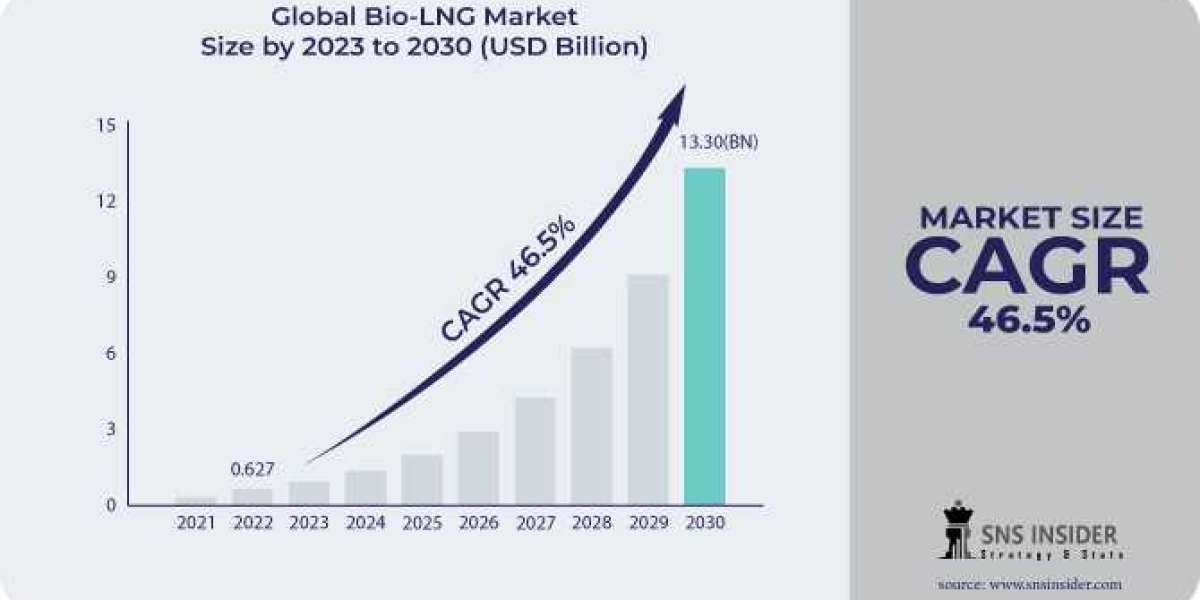The Bio-LNG Market size was valued at USD 0.627 billion in 2022 and is expected to grow to USD 13.30 billion by 2030 and grow at a CAGR of 46.5 % over the forecast period of 2023–2030.
Market Overview
Bio-LNG, or liquefied biomethane, is emerging as a cleaner, renewable alternative to conventional liquefied natural gas (LNG). Produced from organic waste materials, bio-LNG plays a vital role in reducing greenhouse gas emissions and promoting circular economy principles. With its applications spanning transportation and power generation, bio-LNG is poised to become a cornerstone of the global energy transition.
Key Market Segmentation
By Source Type
- Organic Household Waste: Bio-LNG derived from organic household waste is a key component of sustainable waste management strategies. It helps in reducing landfill dependency and offers a renewable energy source for various applications.
- Organic Industrial Waste: Industries generate significant amounts of organic waste, which can be converted into bio-LNG to support sustainable operations and meet carbon reduction targets.
- Municipal Waste: Municipal solid waste, including food scraps and other biodegradable materials, serves as a major source of bio-LNG, contributing to cleaner energy production at the city level.
By Application
- Transportation Fuel: Bio-LNG is increasingly used as a low-emission fuel in heavy-duty vehicles, such as trucks and buses, offering a sustainable alternative to diesel. It also powers maritime vessels as the shipping industry moves toward decarbonization.
- Power Generation: Bio-LNG is utilized in power plants for clean and efficient electricity generation, helping to meet renewable energy targets and reduce reliance on fossil fuels.
- Others: Other applications include heating systems and industrial processes, where bio-LNG provides a sustainable and reliable energy source.
By Region
- North America: The region is witnessing growing investments in bio-LNG infrastructure, driven by stringent emission regulations and the push for renewable energy solutions. The U.S. and Canada are at the forefront of bio-LNG adoption.
- Europe: Europe leads the global bio-LNG market, with countries like Germany, the Netherlands, and Sweden promoting bio-LNG production and usage through supportive policies and incentives.
- Asia-Pacific: Rapid urbanization, coupled with increasing energy demand in countries like China, India, and Japan, is driving bio-LNG adoption in the region. Governments are focusing on waste-to-energy projects to address environmental concerns.
- Latin America: Countries such as Brazil and Argentina are exploring bio-LNG as part of their renewable energy strategies, leveraging abundant agricultural and municipal waste resources.
- Middle East Africa: While still in the nascent stages, the region shows potential for bio-LNG development, especially in countries focusing on waste management and energy diversification.
Read Complete Report Details of Bio-LNG Market 2023–2030@ https://www.snsinsider.com/reports/bio-lng-market-3279
Market Trends and Growth Drivers
- Growing Focus on Decarbonization: The need to reduce carbon emissions across industries is driving the adoption of bio-LNG as a cleaner energy alternative.
- Government Support and Incentives: Policies promoting renewable energy, such as subsidies and tax incentives for bio-LNG projects, are accelerating market growth.
- Technological Advancements: Innovations in waste-to-energy conversion technologies are improving the efficiency and scalability of bio-LNG production.
- Rising Adoption in Transportation: With stricter emission norms and the need for sustainable logistics solutions, bio-LNG is gaining traction in the transportation sector, particularly for long-haul trucking and shipping.
Challenges
- High Initial Investment Costs: The development of bio-LNG production facilities and infrastructure requires significant capital, which could hinder market growth in some regions.
- Feedstock Availability and Quality: The supply of consistent and high-quality organic waste is essential for efficient bio-LNG production, posing challenges in certain areas.
- Infrastructure Development: The lack of widespread refueling and storage infrastructure for bio-LNG remains a barrier to its adoption in key applications.
Key Players:
- Linde plc
- Nordsol
- Flogas Britain Ltd.
- MEGA a.s.
- AXEGAZ TT
- TotalEnergies
- Titan LNG
- DBG Group B.V.
- BoxLNG Pvt. Ltd.
- Shell Pie
Conclusion
The Bio-LNG Market is set to grow rapidly as the world shifts towards cleaner, renewable energy sources. With its ability to transform organic waste into a sustainable energy solution, bio-LNG is positioned to play a crucial role in decarbonizing key sectors such as transportation and power generation. As technological advancements and supportive policies drive market expansion, bio-LNG will emerge as a vital component of the global renewable energy ecosystem.
About the Report
This report provides a detailed analysis of the Bio-LNG Market, including market size, segmentation, regional insights, and growth forecasts. It serves as an essential resource for industry stakeholders, policymakers, and investors seeking to capitalize on the growing demand for sustainable energy solutions.
About Us:
SNS Insider is a global leader in market research and consulting, shaping the future of the industry. Our mission is to empower clients with the insights they need to thrive in dynamic environments. Utilizing advanced methodologies such as surveys, video interviews, and focus groups, we provide up-to-date, accurate market intelligence and consumer insights, ensuring you make confident, informed decisions.
Contact Us:
Akash Anand — Head of Business Development Strategy
info@snsinsider.com
Phone: +1–415–230–0044 (US) | +91–7798602273 (IND)














